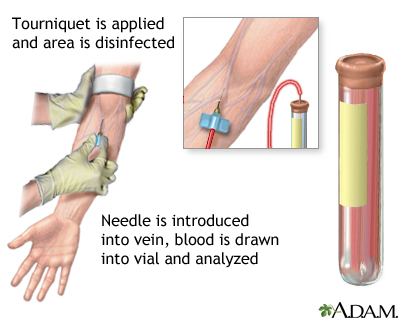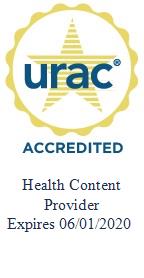Health Library
Blood sugar test
Random blood sugar; Blood sugar level; Fasting blood sugar; Glucose test; Diabetic screening - blood sugar test; Diabetes - blood sugar test
A blood sugar test measures the amount of a sugar called glucose in a sample of your blood.
Glucose is a major source of energy for most cells of the body, including brain cells. Glucose is a building block for carbohydrates. Carbohydrates are found in fruit, cereal, bread, pasta, and rice. Carbohydrates are quickly turned into glucose in your body. This can raise your blood glucose level.
Hormones made in the body help control blood glucose level.
Images

I Would Like to Learn About:
How the Test is Performed
A blood sample is needed.
How to Prepare for the Test
The test may be done in the following ways:
- After you have not eaten anything for at least 8 hours (fasting)
- At any time of the day (random)
- Two hours after you drink a certain amount of glucose (oral glucose tolerance test)
How the Test will Feel
When the needle is inserted to draw blood, some people feel moderate pain. Others feel only a prick or stinging. Afterward, there may be some throbbing or slight bruising. This soon goes away.
Why the Test is Performed
Your health care provider may order this test if you have signs of diabetes. More than likely, the provider will order a fasting blood sugar test.
The blood glucose test is also used to monitor people who already have diabetes.
The test may also be done if you have:
- An increase in how often you need to urinate
- Recently gained a lot of weight
- Blurred vision
- Confusion or a change in the way you normally talk or behave
- Fainting spells
- Seizures (for the first time)
- Unconsciousness or coma
SCREENING FOR DIABETES
This test may also be used to screen a person for diabetes.
High blood sugar and diabetes may not cause symptoms in the early stages. A fasting blood sugar test is almost always done to screen for diabetes for all people over age 35. If you have no other diabetes risk factors, you should be tested every 3 years (more often if your weight is rising).
If you're overweight and have any of the other risk factors below, ask your provider about getting tested at an earlier age and more often:
- High blood sugar level on a previous test
- Blood pressure of 140/90 mm Hg or higher, or unhealthy cholesterol levels
- History of heart disease
- Member of a high-risk ethnic group (African American, Latino, Native American, Asian American, or Pacific Islander)
- Woman who has been previously diagnosed with gestational diabetes
- Polycystic ovary disease (condition in which a woman has an imbalance of female sex hormones causing cysts in the ovaries)
- Close relative with diabetes (such as a parent, brother, or sister)
- Not physically active
Children age 10 and older who are overweight and have at least two of the risk factors listed above should be tested for type 2 diabetes every 3 years, even if they have no symptoms.
Normal Results
If you had a fasting blood glucose test, a level between 70 and 100 mg/dL (3.9 and 5.6 mmol/L) is considered normal.
If you had a random blood glucose test, a normal result depends on when you last ate. Most of the time, the blood glucose level will be 125 mg/dL (6.9 mmol/L) or lower.
The examples above show the common measurements for results of these tests. Normal value ranges may vary slightly among different laboratories. Some labs use different measurements or may test different specimens. Talk to your provider about the meaning of your specific test results.
Blood glucose measured by a blood test from a vein is considered more accurate than blood glucose measured from a fingerstick with a blood glucose meter, or blood glucose measured by a continuous glucose monitor.
What Abnormal Results Mean
If you had a fasting blood glucose test:
- A level of 100 to 125 mg/dL (5.6 to 6.9 mmol/L) means you have impaired fasting glucose, a type of prediabetes. This increases your risk of developing type 2 diabetes and you should consult with your provider.
- A level of 126 mg/dL (7 mmol/L) or higher usually means you have diabetes.
If you had a random blood glucose test:
- A level of 200 mg/dL (11 mmol/L) or higher often means you have diabetes.
- Your provider will order a fasting blood glucose, A1C test, or glucose tolerance test, depending on your random blood glucose test result.
- In someone who has diabetes, an abnormal result on the random blood glucose test may mean that the diabetes is not well controlled. Talk with your provider about your blood glucose goals if you have diabetes.
Other medical problems can also cause a higher-than-normal blood glucose level, including:
- Overactive thyroid gland
- Pancreatic cancer
- Swelling and inflammation of the pancreas (pancreatitis)
- Stress due to trauma, stroke, heart attack, or surgery
- Rare tumors, including pheochromocytoma, acromegaly, Cushing syndrome, or glucagonoma
A lower-than-normal blood glucose level (hypoglycemia) may be due to:
- Hypopituitarism (a pituitary gland disorder)
- Underactive thyroid gland or adrenal gland
- Tumor in the pancreas (insulinoma - very rare)
- Too little food
- Too much insulin or other diabetes medicines
- Liver or kidney disease
- Weight loss after weight loss surgery
- Vigorous exercise
Some medicines can raise or lower your blood glucose level. Before having the test, tell your provider about all the medicines you are taking.
For some thin young women, a fasting blood sugar level below 70 mg/dL (3.9 mmol/L) may be normal.
Risks
There is little risk involved with having your blood taken. Veins and arteries vary in size from one person to another and from one side of the body to the other. Obtaining a blood sample from some people may be more difficult than from others.
Other risks associated with having blood drawn are slight, but may include:
- Excessive bleeding
- Fainting or feeling lightheaded
- Multiple punctures to locate veins
- Hematoma (blood accumulating under the skin)
- Infection (a slight risk any time the skin is broken)
Related Information
DiabetesCarbohydrates
Confusion
Unconsciousness - first aid
Glucagon blood test
Type 1 diabetes
Acromegaly
Cushing syndrome
Hyperthyroidism
Pancreatic cancer
Pheochromocytoma
Low blood sugar
Hypopituitarism
Hypothyroidism
Insulinoma
Acute adrenal crisis
Cushing syndrome due to adrenal tumor
Exogenous Cushing syndrome
Delirium
Dementia
Dementia due to metabolic causes
Diabetic hyperglycemic hyperosmolar syndrome
Diabetic ketoacidosis
Diabetes and kidney disease
Ectopic Cushing syndrome
Epilepsy
Bilateral tonic-clonic seizure
Glucagonoma
Pancreatic islet cell tumor
Multiple endocrine neoplasia (MEN) I
Cushing disease
Type 2 diabetes
Transient ischemic attack
Type 2 diabetes - what to ask your doctor
References
American Diabetes Association. 2. Classification and Diagnosis of Diabetes: Standards of Medical Care in Diabetes-2022. Diabetes Care. 2022. diabetesjournals.org/care/article/45/Supplement_1/S17/138925/2-Classification-and-Diagnosis-of-Diabetes. Accessed April 22, 2022.
US Preventive Services Task Force, Davidson KW, Barry MJ, Mangione CM, et al. Screening for prediabetes and type 2 diabetes: US Preventive Services Task Force recommendation statement. JAMA. 2021;326(8):736-743. PMID: 34427594 pubmed.ncbi.nlm.nih.gov/34427594/.
BACK TO TOPReview Date: 1/9/2022
Reviewed By: Robert Hurd, MD, Professor of Endocrinology and Health Care Ethics, Xavier University, Cincinnati, OH. Review provided by VeriMed Healthcare Network. Also reviewed by David Zieve, MD, MHA, Medical Director, Brenda Conaway, Editorial Director, and the A.D.A.M. Editorial team.
 | A.D.A.M., Inc. is accredited by URAC, for Health Content Provider (www.urac.org). URAC's accreditation program is an independent audit to verify that A.D.A.M. follows rigorous standards of quality and accountability. A.D.A.M. is among the first to achieve this important distinction for online health information and services. Learn more about A.D.A.M.'s editorial policy, editorial process and privacy policy. A.D.A.M. is also a founding member of Hi-Ethics. This site complies with the HONcode standard for trustworthy health information: verify here. |
The information provided herein should not be used during any medical emergency or for the diagnosis or treatment of any medical condition. A licensed medical professional should be consulted for diagnosis and treatment of any and all medical conditions. Links to other sites are provided for information only -- they do not constitute endorsements of those other sites. © 1997- 2022 A.D.A.M., a business unit of Ebix, Inc. Any duplication or distribution of the information contained herein is strictly prohibited.
